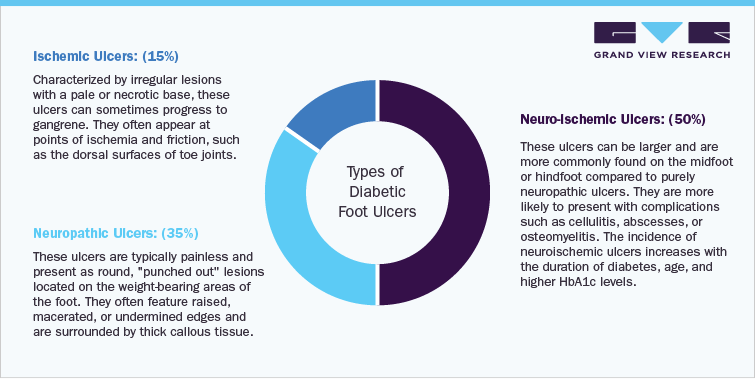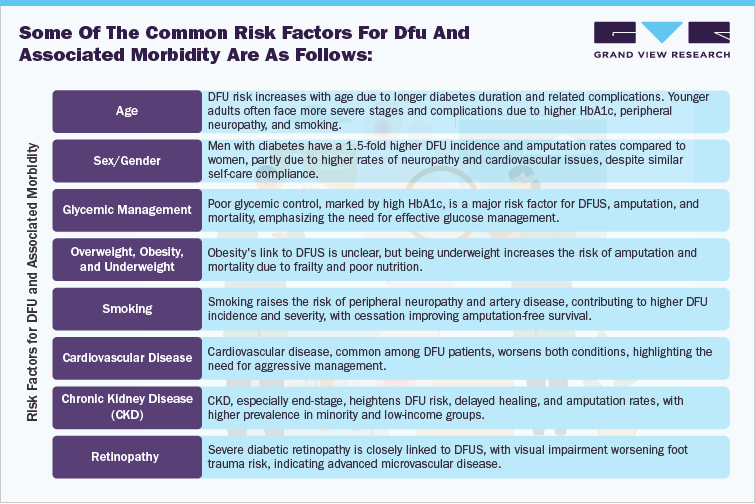- Home
- »
- Market Trend Reports
- »
-
Burden Of Diabetic Foot Ulcers: In-Depth Epidemiology Analysis, 2030
![Global Burden Of Diabetic Foot Ulcers: In-Depth Epidemiology Report]()
Global Burden Of Diabetic Foot Ulcers: In-Depth Epidemiology Analysis, 2018 - 2030
- Published: Aug, 2024
- Report ID: GVR-MT-100215
- Format: PDF, Horizon Databook
- No. of Pages/Datapoints: 50
- Report Coverage: 2024 - 2030
Overview
Diabetic foot ulcer is a severe complication of diabetes mellitus, associated with high morbidity, mortality, and reduced quality of life. The incidence of diabetic foot ulcer (DFU) continues to rise. Among the estimated 537 million people globally living with diabetes, between 19% and 34% are expected to develop a DFU during their lifetime. According to international guidelines, a DFU is defined as a full thickness wound below the ankle in a diabetic patient, regardless of its duration.
Around 20% of those who develop a DFU will need a lower-extremity amputation, either minor (below the ankle), major (above the ankle), or both. Additionally, 10% of individuals diagnosed with a DFU will die within a year. The International Diabetes Federation reports that a limb is lost due to DFU globally every 30 seconds. DFU is a leading cause of hospitalization for diabetic patients and has significant socioeconomic impacts. Diabetic individuals have a 25% lifetime risk of developing DFU, and those with DFU face over twice the mortality risk compared to non-ulcerated diabetic patients, with a five-year mortality rate of around 40%. DFU also contributes to high medical costs and prolonged disability.
The underlying causes of diabetic foot ulcers (DFU) are categorized into three types: neuropathic (35%), ischemic (15%), and neuroischemic (50%). These classifications depend on the presence or absence of peripheral neuropathy (PN) with sensory loss (neuropathic), peripheral artery disease (PAD) (ischemic), or a combination of both (neuroischemic).

Risk Factors for DFU and Associated Morbidity
Both patient-specific and foot-specific factors contribute to the risk of developing diabetic foot ulcers (DFUs). The “at-risk foot” concept, which emphasizes the need for enhanced screening and monitoring, is increasingly central to research and clinical guidelines. Additionally, demographic, socioeconomic, and access-to-care factors play a significant role in DFU risk and complications. Research indicates that risk factors for DFUs are generally consistent across both type 1 and type 2 diabetes, unless specified otherwise.

The comprehensive study, "Global Burden of Diabetic Foot Ulcers: In-Depth Epidemiology Analysis, 2018-2030" provides essential insights into the prevalence, incidence, and trends of diabetic foot ulcers (DFUs) over the study period. This analysis is valuable for a range of stakeholders. Healthcare providers and clinicians will benefit from a deeper understanding of DFU trends and risk factors, allowing them to better identify at-risk patients, implement preventive measures, and refine treatment strategies. Public health officials and policymakers can use the study's findings to guide policy decisions, allocate resources effectively, and design targeted intervention programs to reduce DFU incidence. Medical device and pharmaceutical companies will gain critical insights to inform the development of new products and therapies aimed at improving DFU management. Researchers and academics will find the data useful for advancing the field, identifying research gaps, and setting future research priorities. Additionally, the study has the potential to raise awareness among patients and advocacy groups about the global impact of DFUs, promoting better patient education and support. Overall, this study serves as a vital resource for enhancing the understanding and management of diabetic foot ulcers on a global scale, ultimately contributing to better care and outcomes for those affected.
Report Scope
Attributes
Details
Report Coverage
Epidemiology Study of Diabetic Foot Ulcer by Region
Report Study Period
2018 to 2030
Contents of Report
Epidemiology Study of Diabetic Foot Ulcer by Region:
- Prevalence of Diabetic Foot Ulcer, by Region
- Incidence of Diabetic Foot Ulcer, by Region
- Number of Patients Undergoing Limb Amputation, by Region
- Diabetic Foot Ulcer, Treatment Cost
- Epidemiology of Diabetic Foot Ulcers based on Infection Stage
- Mild Stage
- Moderate Stage
- Severe Stage
- Epidemiology of Diabetic Foot Ulcers based on Ulcer Type
- Neuro-Ischemic Ulcers
- Neuropathic Ulcers
- Ischemic Ulcers
Regional Coverage
Global Epidemiology Study of Diabetic Foot Ulcer by Region:
- North America
- Europe
- Asia Pacific
- Latin America
- Middle East & Africa
Delivery Format
Epidemiology Database in Excel Spreadsheet
Share this report with your colleague or friend.
GET A FREE SAMPLE
This FREE sample includes market data points, ranging from trend analyses to market estimates & forecasts. See for yourself.
![gvr icn]()
NEED A CUSTOM REPORT?
We can customize every report - free of charge - including purchasing stand-alone sections or country-level reports, as well as offer affordable discounts for start-ups & universities.
Contact us now to get our best pricing.
![esomar icon]()
ESOMAR certified & member
![ISO]()
ISO Certified
We are GDPR and CCPA compliant! Your transaction & personal information is safe and secure. For more details, please read our privacy policy.
We are committed towards customer satisfaction, and quality service.
Client Testimonials

"The quality of research they have done for us has been excellent..."
ISO Certified


